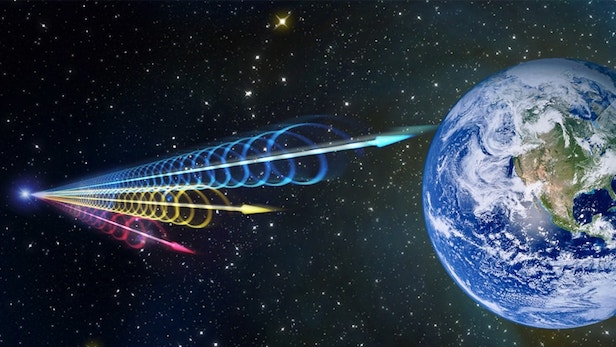Unusual radio signals have been found coming from deep space
Detections of fast radio bursts at low frequencies also provide a new clue to the astrophysical puzzle

Fast radio bursts (FRBs) are short bursts of radio emissions from the sky lasting only few milliseconds. Image credit: Jingchuan Yu/Beijing Planetarium
A Canadian-led team of scientists has found the second repeating fast radio burst (FRB) ever recorded. FRBs are short bursts of radio waves coming from far outside our Milky Way galaxy. Scientists believe FRBs emanate from powerful astrophysical phenomena billions of light years away.
The discovery of the extragalactic signal is among the first, eagerly awaited results from the Canadian Hydrogen Intensity Mapping Experiment (CHIME), a revolutionary radio telescope inaugurated in late 2017 by a collaboration of scientists from Canadian institutions such as University of British Columbia, McGill University, University of Toronto, Perimeter Institute for Theoretical Physics, and the National Research Council of Canada.
In a resounding endorsement of the novel telescope’s capabilities, the repeating FRB was one of a total of 13 bursts detected over a period of just three weeks during the summer of 2018, while CHIME was in its pre-commissioning phase and running at only a fraction of its full capacity. Additional bursts from the repeating FRB were detected in following weeks by the telescope, which is located in British Columbia’s Okanagan Valley.
Of the more than 60 FRBs observed to date, repeating bursts from a single source had been found only once before – a discovery made by the Arecibo radio telescope in Puerto Rico in 2015.
“Until now, there was only one known repeating FRB. Knowing that there is another suggests that there could be more out there. And with more repeaters and more sources available for study, we may be able to understand these cosmic puzzles—where they’re from and what causes them,” says Ingrid Stairs, a member of the CHIME team and an astrophysicist at UBC.
Before CHIME began to gather data, some scientists wondered if the range of radio frequencies the telescope had been designed to detect would be too low to pick up fast radio bursts. Most of the FRBs previously detected had been found at frequencies near 1400 MHz, well above the Canadian telescope’s range of 400 MHz to 800 MHz.
The CHIME team’s results – published on 9 January 2019 in two papers in Nature and presented the same day at the American Astronomical Society meeting in Seattle, Washington, United States – settled these doubts, with the majority of the 13 bursts being recorded well down to the lowest frequencies in CHIME’s range. In some of the 13 cases, the signal at the lower end of the band was so bright that it seems likely other FRBs will be detected at frequencies even lower than CHIME’s minimum of 400 MHz.

The Canadian Hydrogen Intensity Mapping Experiment (CHIME) radio telescope began detected a total of 13 FRBs over the summer of 2018. Image credit: CHIME
The majority of the 13 FRBs detected showed signs of “scattering,” a phenomenon that reveals information about the environment surrounding a source of radio waves. The amount of scattering observed by the CHIME team led them to conclude that the sources of FRBs are powerful astrophysical objects more likely to be in locations with special characteristics.
“That could mean in some sort of dense clump like a supernova remnant,” says team member Cherry Ng, an astronomer at the University of Toronto. “Or near the central black hole in a galaxy. But it has to be in some special place to give us all the scattering that we see.”
Ever since FRBs were first detected, scientists have been piecing together the signals’ observed characteristics to come up with models that might explain the sources of the mysterious bursts and provide some idea of the environments in which they occur. The detection by CHIME of FRBs at lower frequencies means some of these theories will need to be reconsidered.
“Whatever the source of these radio waves is, it’s interesting to see how wide a range of frequencies it can produce. There are some models where intrinsically the source can’t produce anything below a certain frequency,” says team member Arun Naidu of McGill University.
“[We now know] the sources can produce low-frequency radio waves and those low-frequency waves can escape their environment, and are not too scattered to be detected by the time they reach the Earth. That tells us something about the environments and the sources. We haven’t solved the problem, but it’s several more pieces in the puzzle,” says Tom Landecker, a CHIME team member from the National Research Council of Canada.
CHIME is a revolutionary new telescope, designed and built by Canadian astronomers. “CHIME reconstructs the image of the overhead sky by processing the radio signals recorded by thousands of antennas with a large signal processing system,” explains Perimeter Institute’s Kendrick Smith. “CHIME’s signal processing system is the largest of any telescope on Earth, allowing it to search huge regions of the sky simultaneously.”
Keep up to date with the latest news in All About Space – available every month for just £4.99. Alternatively you can subscribe here for a fraction of the price!




